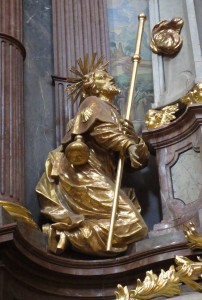The Tragedy of St. Coloman
 It’s a tragedy when any innocent man is accused of being a spy then tortured, hanged and his body left to rot. Sadly, that’s precisely what befell pilgrim monk, St. Coloman one thousand years ago this fall. The wandering monk never reached Jerusalem but, after his death, he was credited with many miracles and was later known as the patron saint of hanged men.
It’s a tragedy when any innocent man is accused of being a spy then tortured, hanged and his body left to rot. Sadly, that’s precisely what befell pilgrim monk, St. Coloman one thousand years ago this fall. The wandering monk never reached Jerusalem but, after his death, he was credited with many miracles and was later known as the patron saint of hanged men.
Coloman, or Colman, became venerated in Europe, but historians know little about his youth, although he may have been the son of an Irish king, according to Professor Dagmar O’ Riain-Raedel, author of Ireland and Austria in the Middle Ages: The Role of the Irish Monks in Austria.
We do know that until his murder in 1012, Coloman lived the life of a pilgrim monk. In this, he was like many of his era. The tradition of the itinerant holy man had long been established and Jerusalem acted as a magnet to the ardently religious soul.
In Journeys on the Edges: The Celtic Tradition, author Thomas O’Loughlin tells how certain Christians believed that “faith had travelled to them, and that they had to travel as part of the demands of being Christians. They valued pilgrimage, and they were conscious of the imagery of the Christian life as a journey towards a homeland: the heavenly Jerusalem.”
Believing this, Coloman embarked on a pilgrimage from the British Isles, undeterred by the fact that such pilgrimages often ended in disaster. Violence frequently erupted around the holy site and there was also plenty of conflict along the way. Many pilgrims were butchered for trivial or fabricated reasons. Some local rulers even killed travelers for sport. Saint Patrick, another holy wanderer, nearly met such a fate.
Coloman’s own pilgrimage came to a brutal end fifteen miles from Vienna, at the Austrian village of Melk, where there was fighting between Austria, Bohemia, and Moravia. Unable to speak the local German tongue, Coloman’s inability to communicate was construed as evasiveness and he was accused of being a Moravian spy.
Crimes of espionage have long been punished by drastic measures. One thousand years ago, hot iron rods and flaming tongs were among the torturer’s tools. If the sufferer somehow managed to survive these horrors, the hangman awaited. Coloman endured agonies and was finally hanged alongside two thieves.
In O’Loughlin’s words, Coloman had viewed Jerusalem as “the heaven toward which he must journey, the destination to which he must direct his boat of flesh.” Instead, he found his earthly destiny at the end of the strangling rope on October 18, 1012.
As was the norm, mutilated and rotting bodies were not buried, but displayed as a warning to anyone who might consider acting against authority. However, while the other victims rotted beneath the sun and were devoured by birds and beasts, Coloman’s corpse was ignored both by animals and the laws of science.
For 18 months, his body failed to decay. To amazed onlookers, it became clear that Coloman was no ordinary man. The immortality of the soul appeared to have migrated to the flesh. The backlash against his murder was intense, and a cult following developed.
In the Catholic Church, the term ‘incorruptible’ has been applied to dead bodies that failed to decompose, and incorruptibility is among the qualities used to establish whether an individual deserves to receive sainthood. Two years after his slaying, a ceremonial funeral was held on the cliffs of Melk and Coloman was made Austria’s first patron saint, becoming one of approximately 80 Catholic saints who have been deemed incorruptible.
In time, many churches in Austria, Bavaria, and Hungary were named after him. The Hungarian monarch King Geza I even named his son Coloman. Centuries later, in 1713, as plague ravaged the land of Melk, a 70lb. wax candle was burned in an effort to summon his benefaction.
Many artistic depictions of the saint have been created. Some are grisly, showing him with a hanging rope and the torturer’s tongs and rod. Others show him with more tranquil objects, such as a book and a maniple (a silk band worn as a Christian symbol around the wrist).
To this day, he is venerated in Ireland, Austria, and other European locations. He is still the patron saint of the town of Melk and each year on October 13th a mass is held in his honour in Melk’s beautiful Benedectine Abbey where his bones are enshrined. October 13th is also his saint day and is celebrated with a big fair. Horses and cattle are brought to Melk, which sits on the River Danube, in the hopes of receiving his blessing.
To many, Coloman’s demise reflects the ongoing universal tragedy that involves persecution of those who, for whatever reason, stand out as different.
As the monks of Melk Abbey have said, “In our times, where listening to each other has become increasingly difficult, he can be seen as a contemporary saint, as he, stranger in a strange land, was not understood. Whoever is different, looks or speaks differently, makes himself suspicious, causes fear, and can easily become the victim of prejudice.” By Ray Cavanaugh




















Thank you for making this available. … have just visited Melk Abbey and discovered The Alter of St Coloman – My family name isp Coleman so keen to follow up with geneology/DNA check.
Fantastic story…thanks for publishing it